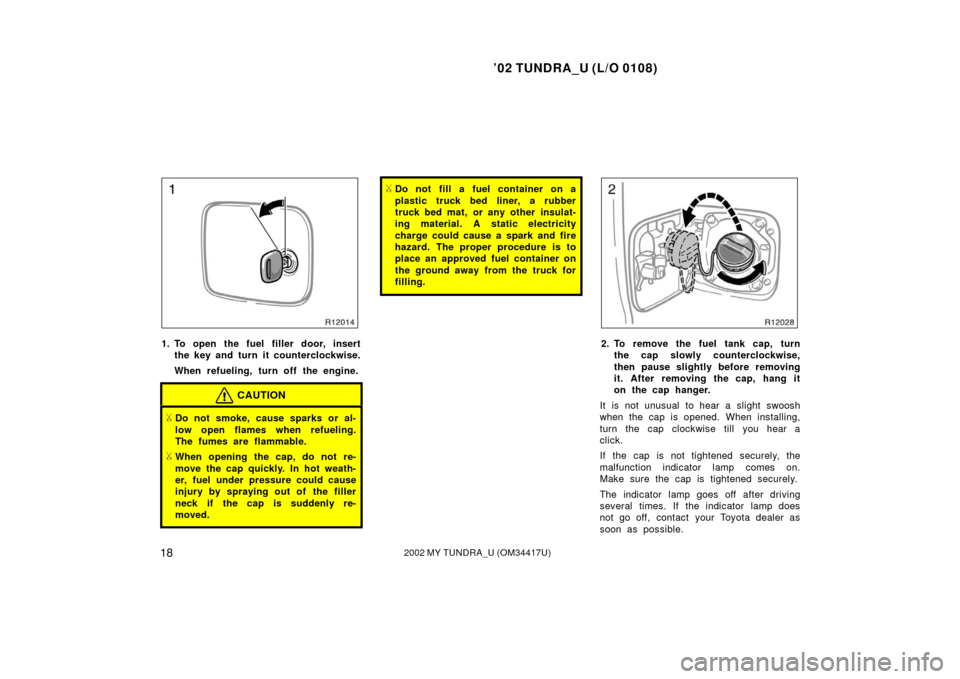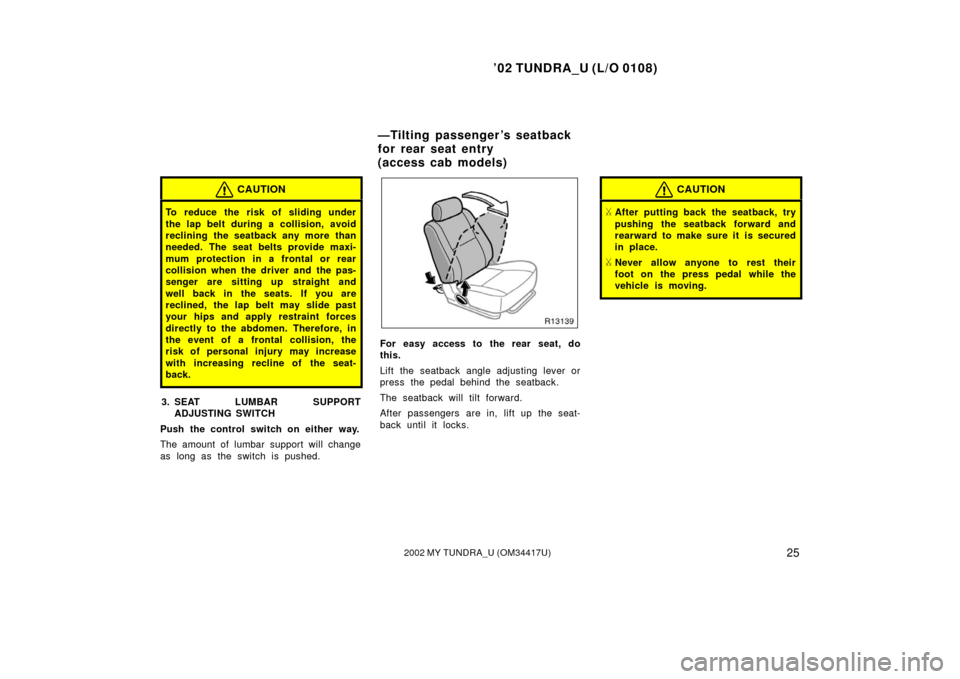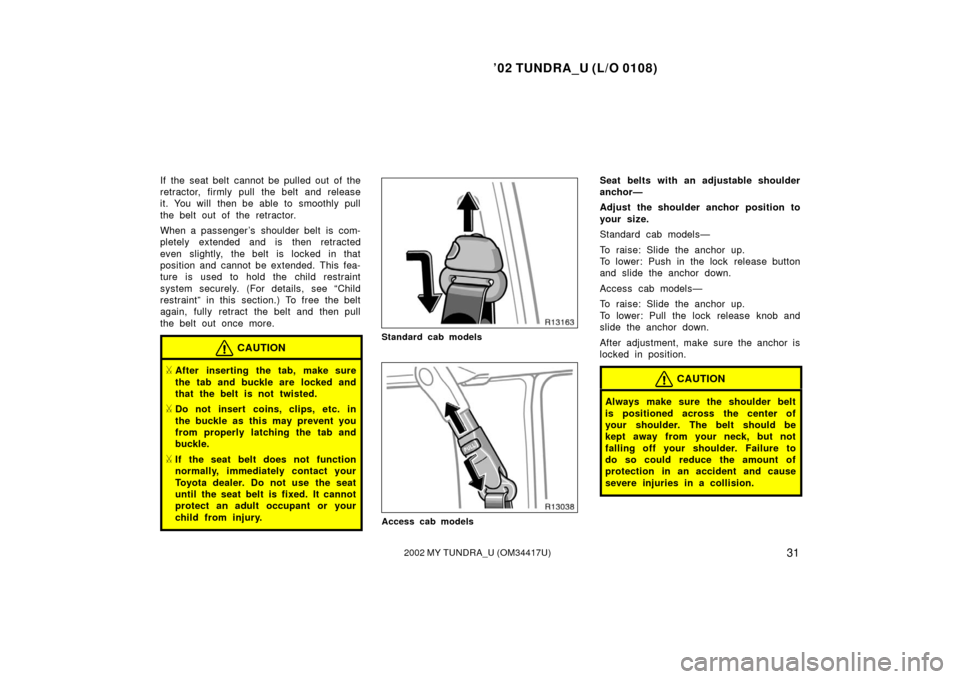Page 22 of 299
’02 TUNDRA_U (L/O 0108)
152002 MY TUNDRA_U (OM 34417U)
OPENING
To open the tailgate, pull the handle up.
The support cables will hold the tailgate
horizontal.
See “Luggage stowage precautions” in
Section 2 for precautions in loading lug-
gage.
After closing the tailgate, try pulling and
pushing it to make sure it is securely
closed.
NOTICE
Avoid driving with the tailgate open.
Support cable bracket
REMOVAL
1. Open the tailgate to the angle where you can release the brackets on the
support cables from the lugs on
both sides.
To release the support cable bracket, lift
it up and slide it off.2. Tilt the tailgate to about 30 ° from
vertical and pull up the right side of
the tailgate to unhook the right side.
Tailgate
Page 23 of 299
’02 TUNDRA_U (L/O 0108)
162002 MY TUNDRA_U (OM 34417U)
3. Slide the tailgate a little to the right
to unhook the left side.
To attach the tailgate, follow the removal
procedure in reverse order.
After closing the tailgate, try pulling it to-
ward you to make sure it is securely
closed.
We recommend you keep the tailgate
closed when not in use.
NOTICE
Make sure the support brackets are
securely latched on both side panels
when installing the tailgate.
LOCKING AND UNLOCKING WITH KEY
Insert the key into the keyhole and turn
it to lock or unlock the tailgate.
To lock: Turn the key clockwise.
To unlock: Turn the key counterclockwise.To open the hood: 1. Pull the hood lock release lever. The hood will spring up slightly.
CAUTION
Before driving, be sure that the hood
is closed and securely locked. Other-
wise, the hood may open unexpected-
ly while driving and an accident may
occur.
Hood
Page 25 of 299

’02 TUNDRA_U (L/O 0108)
182002 MY TUNDRA_U (OM 34417U)
1. To open the fuel filler door, insert
the key and turn it counterclockwise.
When refueling, turn off the engine.
CAUTION
�Do not smoke, cause sparks or al-
low open flames when refueling.
The fumes are flammable.
�When opening the cap, do not re-
move the cap quickly. In hot weath-
er, fuel under pressure could cause
injury by spraying out of the filler
neck if the cap is suddenly re-
moved.
�Do not fill a fuel container on a
plastic truck bed liner, a rubber
truck bed mat, or any other insulat-
ing material. A static electricity
charge could cause a spark and fire
hazard. The proper procedure is to
place an approved fuel container on
the ground away from the truck for
filling.
2. To remove the fuel tank cap, turnthe cap slowly counterclockwise,
then pause slightly before removing
it. After removing the cap, hang it
on the cap hanger.
It is not unusual to hear a slight swoosh
when the cap is opened. When insta lling,
turn the cap clockwise till you hear a
click.
If the cap is not tightened securely, the
malfunction indicator lamp comes on.
Make sure the cap is tightened securely.
The indicator lamp goes off after driving
several times. If the indicator lamp does
not go off, contact your Toyota dealer as
soon as possible.
Page 32 of 299

’02 TUNDRA_U (L/O 0108)
252002 MY TUNDRA_U (OM 34417U)
CAUTION
To reduce the risk of sliding under
the lap belt during a collision, avoid
reclining the seatback any more than
needed. The seat belts provide maxi-
mum protection in a frontal or rear
collision when the driver and the pas-
senger are sitting up straight and
well back in the seats. If you are
reclined, the lap belt may slide past
your hips and apply restraint forces
directly to the abdomen. Therefore, in
the event of a frontal collision, the
risk of personal injury may increase
with increasing recline of the seat-
back.
3. SEAT LUMBAR SUPPORT
ADJUSTING SWITCH
Push the control switch on either way.
The amount of lumbar support will change
as long as the switch is pushed.
For easy access to the rear seat, do
this.
Lift the seatback angle adjusting lever or
press the pedal behind the seatback.
The seatback will tilt forward.
After passengers are in, lift up the seat-
back until it locks.
CAUTION
�After putting back the seatback, try
pushing the seatback forward and
rearward to make sure it is secured
in place.
�Never allow anyone to rest their
foot on the press pedal while the
vehicle is moving.
—Tilting passenger ’s seatback
for rear seat entry
(access cab models)
Page 33 of 299
’02 TUNDRA_U (L/O 0108)
262002 MY TUNDRA_U (OM 34417U)
Pull the seatback lock release lever and
fold down the seatback.
Hold the lever until you have swung the
seatback forward slightly.
CAUTION
When returning the seatback to the
upright position, observe the follow-
ing precautions in order to prevent
personal injury in a collision or sud-
den stop:
�Make sure the seatback is securely
locked by pushing forward and rear-
ward on the top of the seatback.
Failure to do so will prevent the
seat belt from operating properly.
�Make sure the seat belts are not
twisted or caught in the seatback
and are arranged in their proper
position and are ready to use.
Ty p e A
—Folding seatback
(non�split bench seat) Armrest
Page 35 of 299
’02 TUNDRA_U (L/O 0108)
282002 MY TUNDRA_U (OM 34417U)
2. Raise the bottom cushion while
pushing the lock release lever.
CAUTION
When returning the bottom cushion to
its original position, observe the fol-
lowing precautions in order to pre-
vent personal injury in a collision or
sudden stop:
�Make sure the bottom cushion is
securely locked by trying to pull up
the edge of the bottom cushion.
Failure to do so will prevent the
seat belt from operating properly.
�Make sure the seat belts are not
twisted or caught under the bottom
cushion and are arranged in their
proper position and are ready to
use.Front
Rear
Head restraints
Page 36 of 299

’02 TUNDRA_U (L/O 0108)
292002 MY TUNDRA_U (OM 34417U)
For your safety and comfort, adjust the
head restraint before driving.
To raise: Pull it up.
To lower: Push it down while pressing the
lock release button.
The head restraint is most effective when
it is close to your head. Therefore, using
a cushion on the seatback is not recom-
mended.
CAUTION
�Adjust the center of the head re-
straint so that it is closest to the
top of your ears.
�After adjusting the head restraint,
make sure it is locked in position.
�Do not drive with the head re-
straints removed.
Toyota strongly urges that the driver and
passengers in the vehicle be properly re-
strained at all times with the seat belts
provided. Failure to do so could increase
the chance of injury and/or the severity of
injury in accidents.
Child. Use a child restraint system ap-
propriate for the child until the child be-
comes large enough to properly wear the
vehicle’s seat belts. See “Child restraint”
for details.
STANDARD CAB MODELS—
If a child is too large for a child restraint
system, the child s hould sit in the seat
and must be restrained using the vehicle’s
seat belt.
ACCESS CAB MODELS—
If a child is too large for a child restraint
system, the child s hould sit in the rear
seat and must be restrained using the
vehicle’s seat belt. According to accident
statistics, the child is safer when properly
restrained in the rear seat than in the
front seat.
If a child must sit in the front seat, the
seat belts should be worn properly. If an
accident occurs and the seat belts are not
worn properly, the force of the rapid infla-
tion of the airbag may cause death or
serious injury to the child. Do not allow the child to stand up or
kneel on either rear or front seats. An
unrestrained child could suffer serious in-
jury or death during emergency braking or
a collision. Also, do not let the child sit
on your lap. It does not provide sufficient
restraint.
Small�framed person or youth in a
3�point type seat belt.
On models with
a non�split bench seat, have a small�
framed person or youth sit slightly closer
to the center of the vehicle (so the shoul-
der belt does not cross over the neck).
On models with separate seats and a split
bench seat, move the seat fully backward .
Pregnant woman. Toyota recommends the
use of a seat belt. Ask your doctor for
specific recommendations. The lap belt
should be worn securely and as low as
possible over the hips and not on the
waist.
Injured person. Toyota recommends the
use of a seat belt. Depending on the inju-
ry, first check with your doctor for specific
recommendations.
Seat belts—
—Seat belt precautions
Page 38 of 299

’02 TUNDRA_U (L/O 0108)
312002 MY TUNDRA_U (OM 34417U)
If the seat belt cannot be pulled out of the
retractor, firmly pull the belt and release
it. You will then be able to smoothly pull
the belt out of the retractor.
When a passenger ’s shoulder belt is com-
pletely extended and is then retracted
even slightly, the belt is locked in that
position and cannot be extended. This fea-
ture is used to hold the child restraint
system securely. (For details, see “Child
restraint” in this section.) To free the belt
again, fully retract the belt and then pull
the belt out once more.
CAUTION
�After inserting the tab, make sure
the tab and buckle are locked and
that the belt is not twisted.
�Do not insert coins, clips, etc. in
the buckle as this may prevent you
from properly latching the tab and
buckle.
�If the seat belt does not function
normally, immediately contact your
Toyota dealer. Do not use the seat
until the seat belt is fixed. It cannot
protect an adult occupant or your
child from injury.
Standard cab models
Access cab models
Seat belts with an adjustable shoulder
anchor—
Adjust the shoulder anchor position to
your size.
Standard cab models—
To raise: Slide the anchor up.
To lower: Push in the lock release button
and slide the anchor down.
Access cab models—
To raise: Slide the anchor up.
To lower: Pull the lock release knob and
slide the anchor down.
After adjustment, make sure the anchor is
locked in position.
CAUTION
Always make sure the shoulder belt
is positioned across the center of
your shoulder. The belt should be
kept away from your neck, but not
falling off your s houlder. Failure to
do so could reduce the amount of
protection in an accident and cause
severe injuries in a co llision.